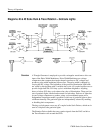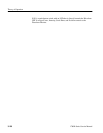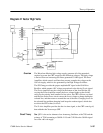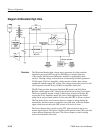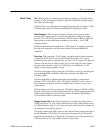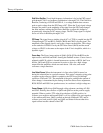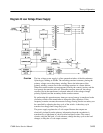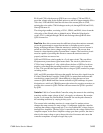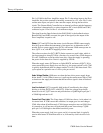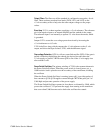
Theory of Operation
3–112
1780R-Series Service Manual
Grid Drive Rectifier. Z-axis high frequency information is fed to the CRT control
grid through C240. Low frequency information is through C241. The Grid Drive
Rectifier, consisting of CR140 and CR141, is a voltage doubler that converts
peak-to-peak voltage from the PP Clamp to DC. When the Z-axis signal voltage
changes, the peak-to-peak amplitude of the signal from the PP Clamp changes
the same amount, causing the Grid Drive Rectifier to reflect this change by
proportionally changing its DC output voltage. The PP Clamp signal is coupled
across a 4 kilovolt boundary through C241.
PP Clamp. The signal from a winding (pins 6 & 7) of T250 is coupled into the PP
Clamp through C512 and R510. Diodes CR450 and CR451 clip the signal. The
amplitude of the clipped signal is set by the voltages on the diodes. The voltage
on the cathode of CR450 is set by the CRT bias control (R420) and the anode
voltage on CR451 is the same as the output of the Z-Axis Amplifier, which is a
dynamic signal.
Focus Amp. The Focus Amp consists of Q440, Q430, Q330 with R550 as the
input resistor, and R440 and R443 forming the feedback resistor. Coarse focus is
adjusted with R130, which is located between two sections of R330, the Focus
divider. Q430 and Q330 are connected in series to allow for a high voltage
output from the amplifier, which can reach about –500 volts, and would
overstress a single transistor.
Line Select Focus. When the instrument is in line select, Q460 is turned on
during the selected line in a periodic manner. This causes a negative-going pulse
to appear on the collector, which is coupled to the CRT focus grid through
capacitors C365 and C251. The amplitude of the pulse, and thus the amount of
focus change, is determined by the setting of the Line Select Focus adjustment,
R350. DS362 and DS361 are spark arrestors, in case there is a high voltage arc.
Cursor Shaper. Q450 drives Q462 through a delay element consisting of L560
and C562. Initially, the collectors of Q450 and Q462 are at the positive supply
potential. When a positive TTL edge drives the base of Q450 positive, its
collector goes negative and because Q462 is off, its collector also goes negative.
A few nanoseconds later, Q462 is turned on through L560 and C562, and its
collector goes back positive. Q461 and Q463 are emitter followers that drive
signal current into the cathode of the CRT.



